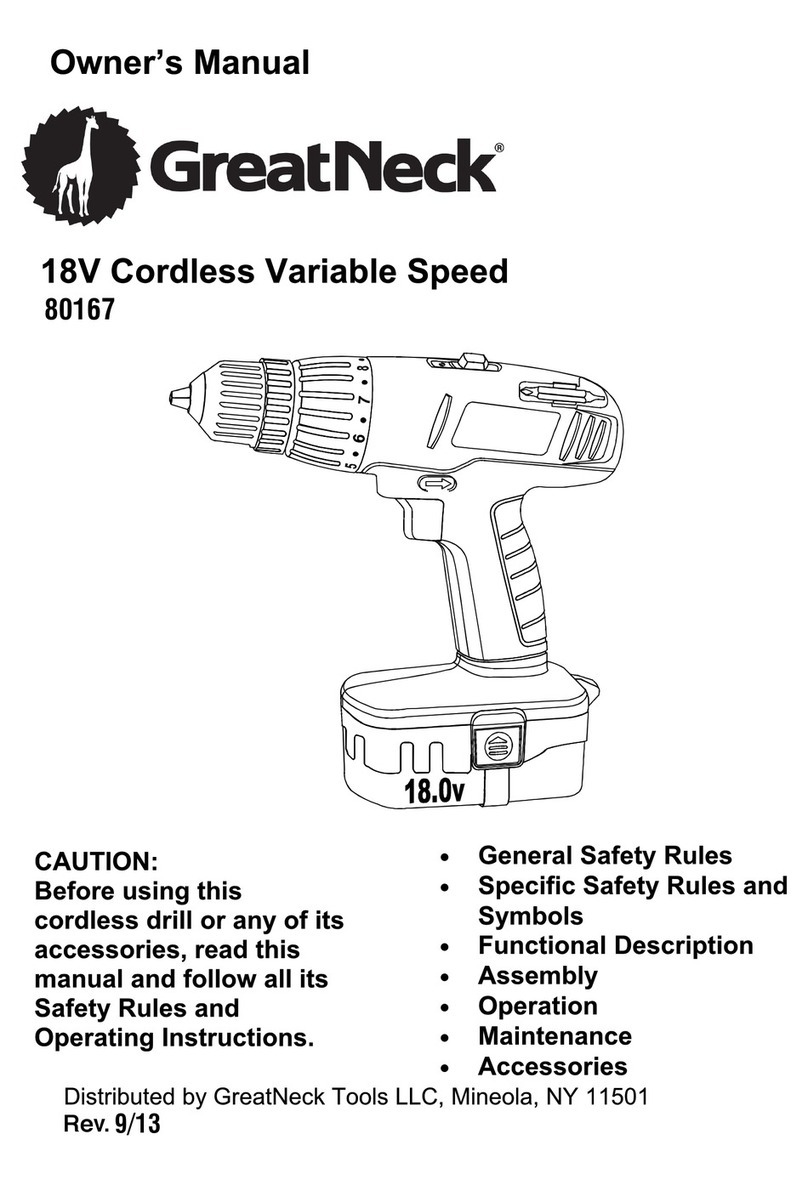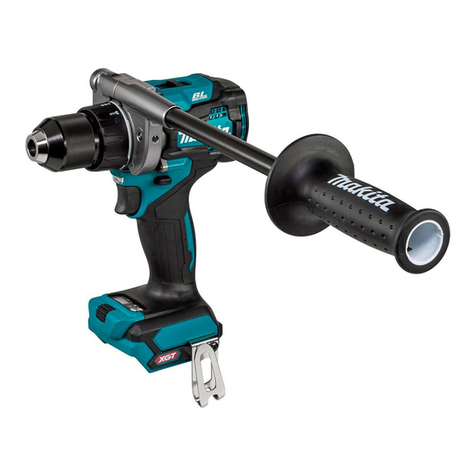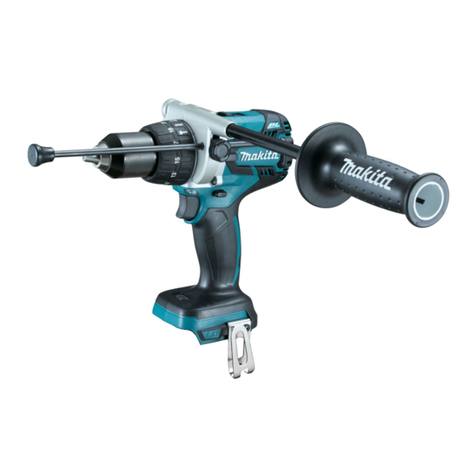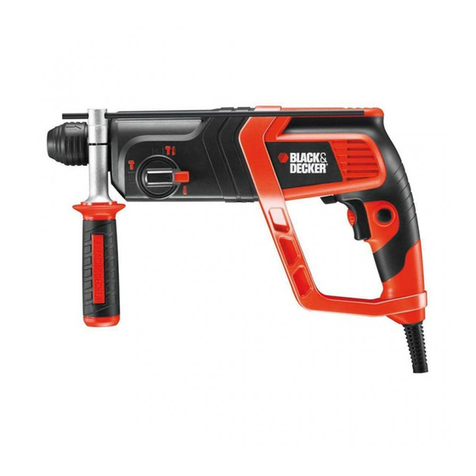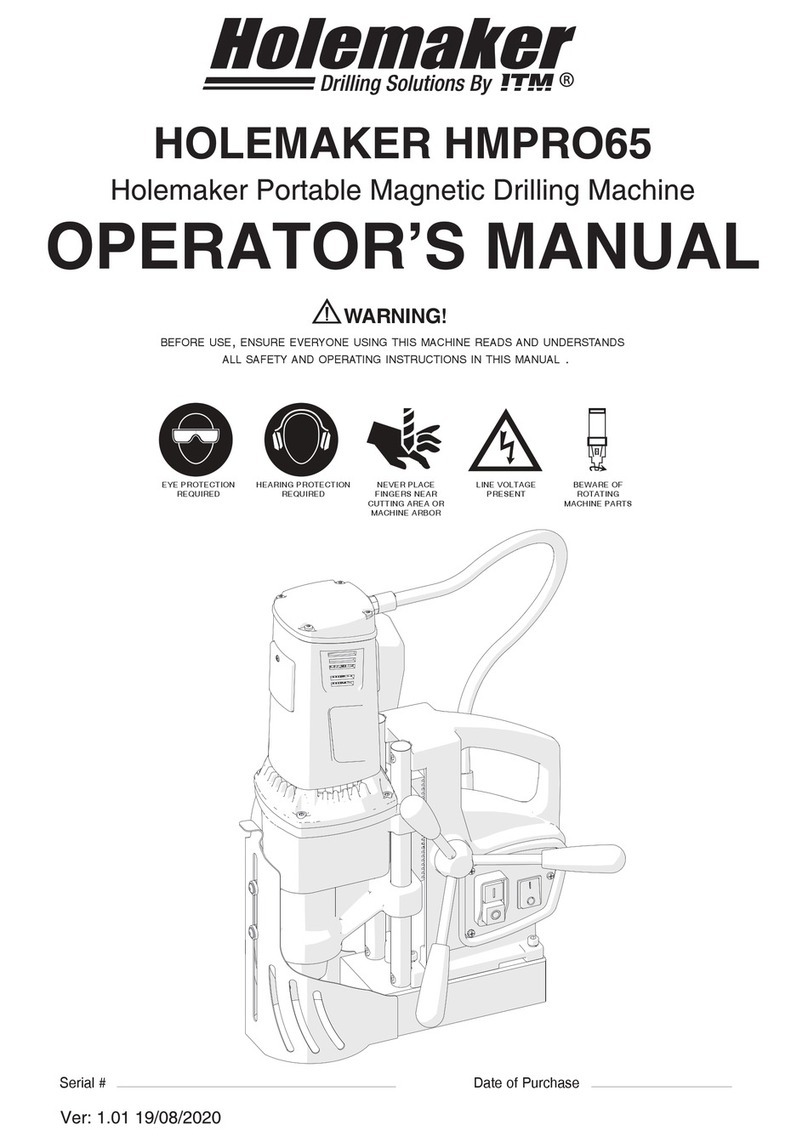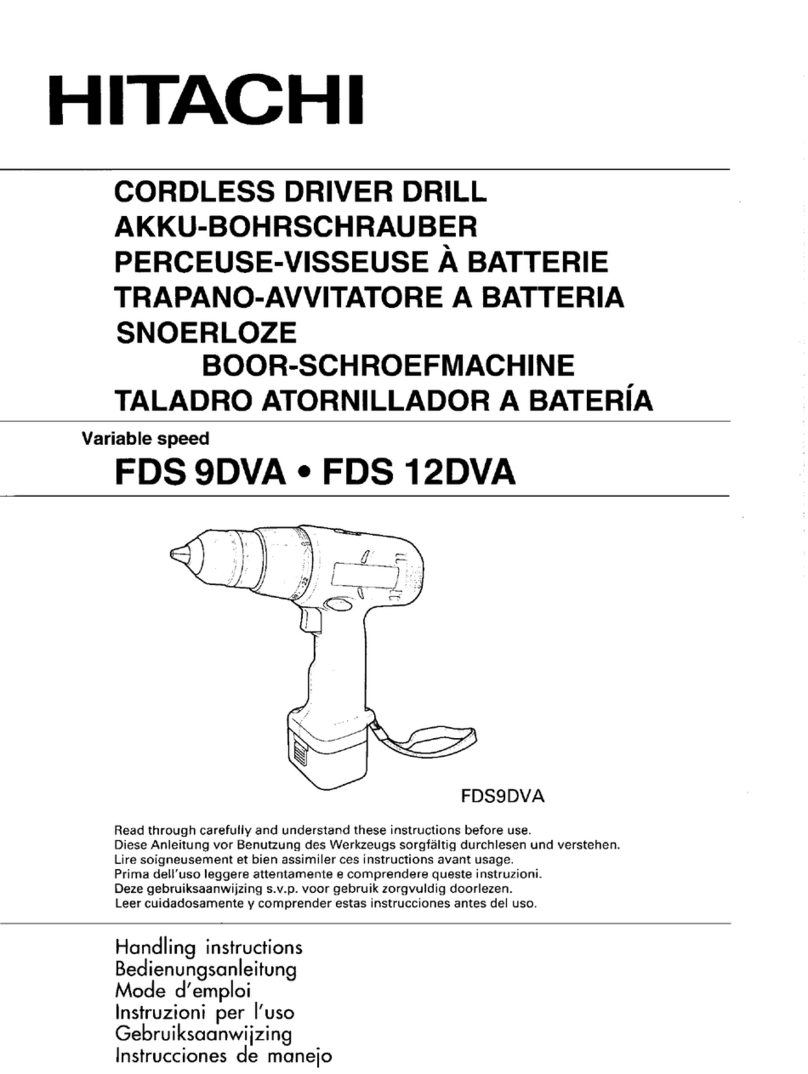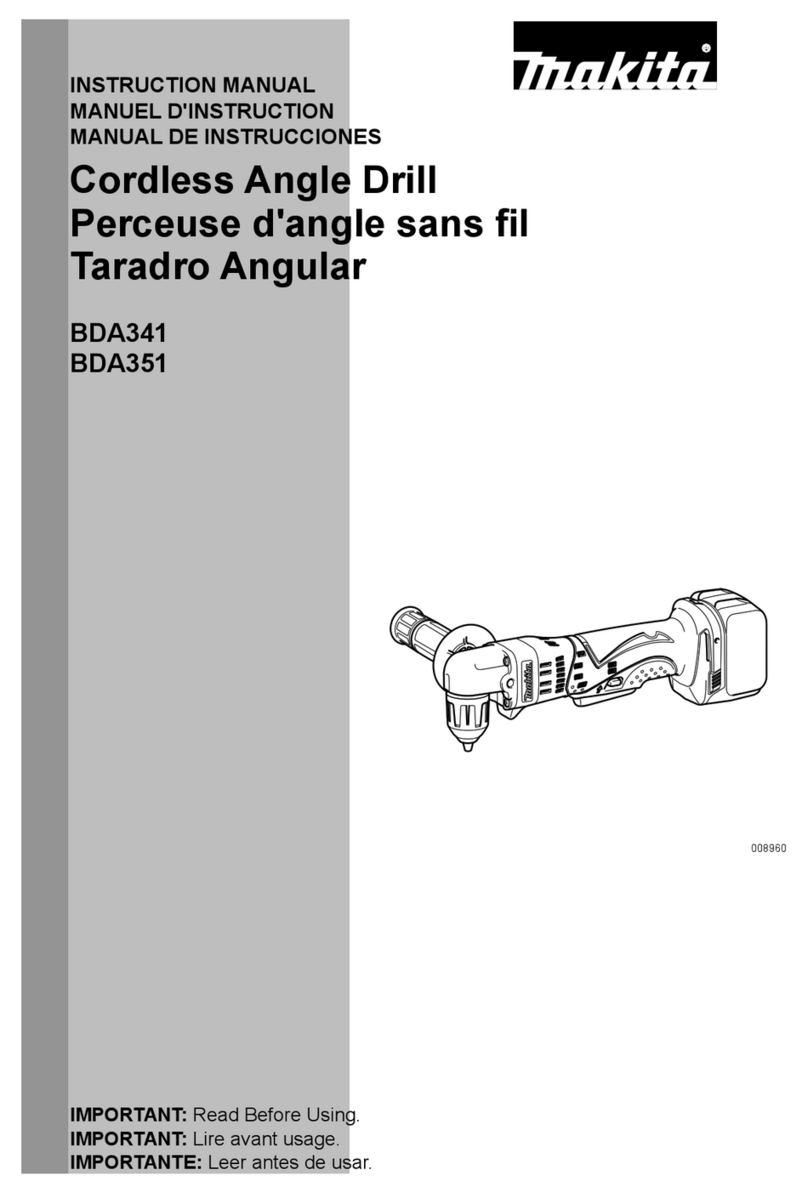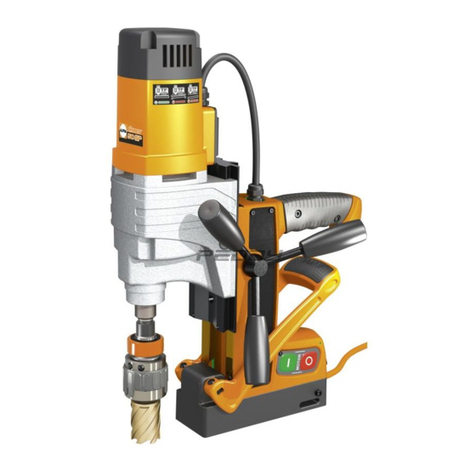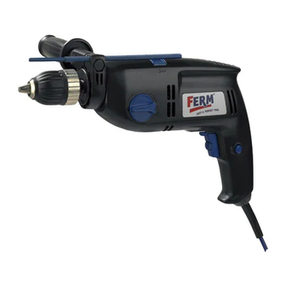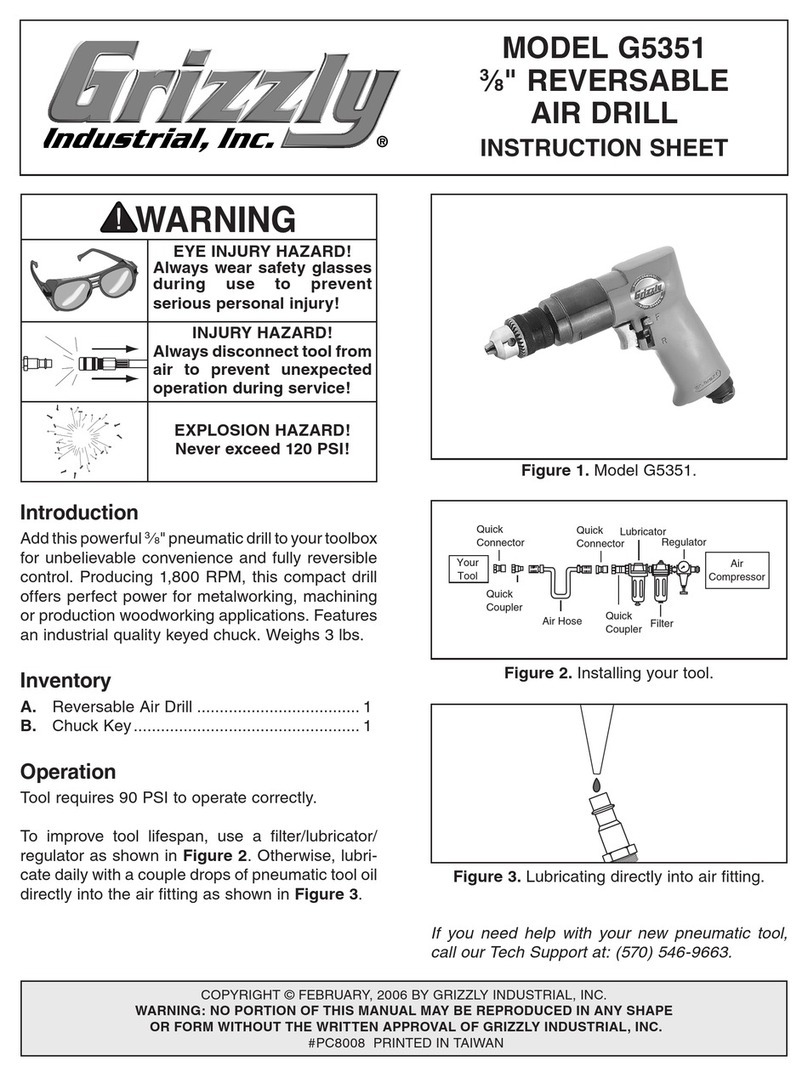Greatneck 80159 User manual

PRODUCT SPECIFICATIONS
Rating:
120 V, 60 Hz, AC
Amperes:
6.3 Amp
Motor speed:
0–2800 RPM (no load)
Chuck:
1/2” Keyed
Maximum drilling
capacity in metal:
3/8” (10 mm)
Beats per minute:
0–44800
TOLL FREE HELPLINE 1-800-458-2472
Owner’s Manual
1/2" Hammer Drill
80159

2
Product specifications ………….…………………………………………………….
1
Table of contents ……………………………………………………………………...
2
General safety warnings ……………………………………………………………..
3–4
Eye, ear & lung protection …………………………………………………
3–4
Electrical safety …………………………………………………………….
4
Power tool safety ……………………………………………………………………...
5–6
General safety rules ………………………………………………………..
5
Work area …………………………………………………………………...
5
Electrical safety …………………………………………………………….
5
Personal safety …………………………………………………………….
5–6
Tool use and care ………………………………………………………….
6
Service ………………………………………………………………………
6
Specific safety rules …………………………………………………………………..
7
Extension cord safety ………………………………………………………………...
8
Symbols ………………………………………………………………………………..
9
Know your impact drill ………………………………………………………………..
10
Accessories and carton contents ……………………………………………………
11
Assembly and operation ……………………………………………………………..
12–20
Forward/reverse switch ……………………………………………………
12
Variable speed trigger switch ……………………………………………..
12
Trigger switch lock …………………………………………………………
13
Drill / impact switch ………………………………………………………..
13
Installing auxiliary handle ………………………………………………….
14
Installing depth rod …………………………………………………………
14–15
Installing bits ………………………………………………………………..
15–16
Removing bits ………………………………………………………………
16
Drilling ……………………………………………………………….………
17–18
Drilling in concrete …………………………………………………………
18
Chuck removal ……………………………………………………………..
19
Retightening loose chuck ………………………………………….………
20
Maintenance …………………………………………………………………………..
20
Parts diagram ………………………………………………………………………….
21
Parts list ………………………………………………………………………………..
22
Warranty ……………………………………………………………………….………
23
TABLE OF CONTENTS

3
EYE, EAR & LUNG PROTECTION
This instruction manual includes the following:
• General Safety Rules
• Specific Safety Rules and Symbols
• Functional Description
• Assembly
• Operation
• Maintenance
• Accessories
!
ALWAYS WEAR EYE PROTECTION THAT CONFORMS WITH CSA
REQUIREMENTS or ANSI SAFETY STANDARD Z87.1
FLYING DEBRIS can cause permanent eye damage. Prescription
eyeglasses ARE NOT a replacement for proper eye protection.
WARNING: Non-compliant eyewear can cause serious injury if
broken during operation of a power tool.
SAVE THESE INSTRUCTIONS FOR REFERENCE
WARNING: Use hearing protection, particularly during extended
periods of operation of the tool or if the operation is noisy.
!
CAUTION: Before using this tool or any of its accessories, read this
manual and follow all Safety Rules and Operating Instructions.
!
GENERAL SAFETY WARNINGS

4
ELECTRICAL SAFETY
WARNING: To avoid electrical hazards, fire hazards or damage to the
tool, use proper circuit protection.
This tool is wired at the factory for 110–120 V operation. It must be
connected to a 110–120 V 15 A time delayed fuse or circuit breaker. To
avoid shock or fire, replace power cord immediately if it is worn, cut or
damaged in any way.
ALWAYS WEAR A DUST MASK DESIGNED FOR USE WHEN
OPERATING A POWER TOOL IN A DUSTY ENVIRONMENT.
WARNING: Some dust created by power sanding, sawing, grinding,
drilling and other construction activities contains chemicals known to cause
cancer, birth defects or other reproductive harm. Some examples of these
chemicals are:
• Lead from lead-based paints
• Crystalline silica from bricks, cement and other masonry products
• Arsenic and chromium from chemically-treated lumber
Your level of risk from these exposures varies, depending on how often you
do this type of work. To reduce your exposure to these chemicals, work in a
well-ventilated area and work with approved safety equipment such as dust
masks that are specially designed to filter out microscopic particles.
!
GENERAL SAFETY WARNINGS

GENERAL SAFETY RULES
WARNING: Read and understand
all instructions. Failure to follow all
instructions listed below may result in
electric shock, fire and/or serious personal
injury.
WORK AREA
Keep your work area clean and well lit.
Cluttered benches and dark areas invite
accidents.
Do not operate power tools in potentially
explosive environments, such as in the
presence of flammable liquids, gas or dust.
Power tools create sparks which may
ignite the dust or fumes.
Keep bystanders, children and visitors
away while operating the tool. Distractions
can cause you to lose control.
ELECTRICAL SAFETY
Double insulated tools are equipped with a
polarized plug (one blade is wider than the
other). This plug will fit in a polarized plug
only one way.
If the plug does not fit fully into the outlet,
reverse the plug. If it still does not fit,
contact a qualified electrician to install a
polarized outlet. Do not alter the plug in
any way. Double insulation eliminates the
need for the three-prong grounded power
cord and grounded power supply system.
Avoid body contact with grounded surfaces
such as pipes, radiators, ranges and
refrigerators. There is increased risk of
electric shock if your body is grounded.
Do not expose power tools to rain or wet
conditions. Water entering the power tool
will increase the risk of electric shock.
Do not abuse the cord. Never use the cord
to carry the tool or pull the plug from an
outlet. Keep cord away from heat, oil,
sharp edges or moving parts. Replace
damaged cords immediately. Damaged
cords increase the risk of electric shock.
When operating a power tool outdoors, use
an outdoor extension cord marked “W-A”
or “W”. These cords are rated for outdoor
use and reduce the risk of electric shock.
PERSONAL SAFETY
Stay alert, watch what you are doing and
use common sense when operating a
power tool. Do not use the tool while tired
or under the influence of drugs, alcohol or
medication. A moment of inattention while
operating power tools may result in serious
personal injury.
Dress properly. Do not wear loose clothing
or jewelry.
Contain long hair. Keep your hair, clothing
and gloves away from moving parts. Loose
clothing, jewelry or long hair can be caught
in moving parts.
!
POWER TOOL SAFETY
5

6
PERSONAL SAFETY – cont’d
Avoid accidental starting. Be sure the
switch is OFF before plugging in. Carrying
tools with your finger on the switch or
plugging in tools that have the switch ON
invites accidents.
Remove adjusting keys or wrenches
before turning the tool ON. A wrench or
key that is left attached to a rotating part of
the tool may result in personal injury.
Do not overreach. Keep proper footing and
balance at all times. Proper footing and
balance enables better control of the tool in
unexpected situations.
Use safety equipment. Always wear eye
protection.
Dust mask, non-skid safety shoes, hard
hat or hearing protection must be used for
appropriate conditions.
TOOL USE AND CARE
Use clamps or another practical way to
secure and support the workpiece to a
stable platform. Holding the work by hand
or against your body is unstable and may
lead to loss of control.
Do not force the tool. Use the correct tool
for your application. The correct tool will do
the job better and safer at the rate for
which it was designed.
Do not use the tool if the power switch
does not turn it ON or OFF. Any tool that
cannot be controlled with the switch is
dangerous and must be repaired.
Disconnect the plug from the power source
before making any adjustments, changing
accessories or storing the tool. Such
preventive safety measures reduce the risk
of starting the tool accidentally.
Store idle tools out of reach of children and
other untrained persons. Tools are
dangerous in the hands of untrained users.
Maintain tools with care. Keep cutting tools
sharp and clean. Properly maintained
cutting tools with sharp cutting edges are
less likely to bind and are easier to control.
Check for misalignment or binding of
moving parts, breakage of parts and any
other condition that may affect the tool’s
operation. If damaged, have the tool
serviced before using. Many accidents are
caused by poorly maintained tools.
Use only accessories that are
recommended by the manufacturer for
your model. Accessories that may be
suitable for one tool may become
hazardous when used on another tool.
SERVICE
Tool service must be performed only by
qualified personnel. Service or
maintenance performed by unqualified
personnel could result in risk of injury.
When servicing a tool, use only identical
replacement parts. Follow instructions in
the Maintenance section of this manual.
Use of unauthorized parts or failure to
follow Maintenance instructions may create
a risk of electric shock or injury.
POWER TOOL SAFETY

7
WARNING: Know your impact
drill. Read the Owner’s Manual
carefully. Learn the tool’s applications
and limitations, as well as the specific
potential hazards related to this tool.
Following this rule will reduce the risk of
electric shock, fire or serious injury.
WARNING: Never use the drill in
“impact” mode unless a proper
masonry bit is installed and you are
drilling in concrete.
WARNING: Always use safety
shield, hearing protection and dust
mask when operating the drill in
“impact” mode.
Wear eye protection. Use face or dust
mask along with safety goggles if operation
is dusty. Use hearing protection,
particularly during extended periods of
operation.
Do not wear gloves, neckties or loose
clothing.
Do not drill material too small to be
securely held.
Always keep hands out of the path of the
drill bit. Avoid awkward hand positions
where a sudden slip could cause your
hand to move into the path of the drill bit.
Secure workpiece. Use clamps or a vice to
hold the work when practical. It is safer
than using your hand and it frees both
hands to operate the tool.
Make sure there are no nails or foreign
objects in the part of the workpiece to be
drilled.
To avoid injury from accidental starting,
always remove the plug from the power
source before installing or removing a drill
bit, accessory or attachment.
Do not install or use any drill bit that
exceeds 7” (175 mm) in length or extends
more than 6” (150 mm) beyond the chuck
jaws. They can suddenly bend or break.
Before starting the operation, jog the drill
switch to make sure the drill bit does not
wobble or vibrate.
Do not use fly cutters or multiple-part hole
cutters, as they can come apart or become
unbalanced in use.
Make sure the spindle has come to a
complete stop before touching the chuck or
attempting to change the drill bit.
Always make sure the chuck is tight and
the drill bit firmly tightened in the chuck
before starting drill.
!
SPECIFIC SAFETY RULES
!
!

8
WARNING: Keep the extension
cord clear of the working area. Position
the cord so it will not get caught on the
workpiece, tools or any other obstructions
while you are working with the power tool.
Make sure any extension cord used with
this tool is in good condition. When using
an extension cord, be sure to use one of
heavy enough gauge to carry the current
the tool will draw. An undersized cord will
cause a drop in line voltage resulting in
loss of power and overheating.
The table at right shows the correct size to
use according to cord length and
nameplate ampere rating. If in doubt, use
the next heavier gauge. The smaller the
gauge number the heavier the cord.
Be sure your extension cord is properly
wired and in good condition. Always
replace a damaged extension cord or have
it repaired by a qualified electrician before
using it. Protect your extension cord from
sharp objects, excessive heat and damp or
wet areas.
Use a separate electrical circuit for your
power tools. This circuit must not be less
than 14 gauge wire and should be
protected with either a 15 A time delayed
fuse or circuit breaker. Before connecting
the power tool to the power source, make
sure the switch is in the OFF position and
the power source is the same as indicated
on the nameplate. Running at lower
voltage will damage the motor.
!
EXTENSION CORD SAFETY
MINIMUM GAUGE (AWG)
EXTENSION CORDS (120 V use only)
Amperage
rating
Total length
More
than
Not
more
than
25'
(7.5 m)
50'
(15 m)
100'
(30 m)
150'
(45 m)
0
6
18
16
16
14
6
10
18
16
14
12
10
12
16
16
14
12
12
16
14
12
Not Applicable

9
V
volts
A
amperes
Hz
hertz
W
watt
kW
kilowatts
microfarads
L
liters
kg
kilograms
H
hours
N/cm2
newtons per square
centimeter
Pa
pascals
Min
minutes
S
seconds
alternating current
three-phase alternating
current
three-phase alternating
current with neutral
direct current
no load speed
alternating or direct
current
class II construction
splash proof
construction
watertight construction
protective earthing at
earthing terminal, Class I
tools
revolutions or
reciprocations per
minute
diameter
off position
arrow
warning symbol
WARNING: Some of the symbols below may be used on your tool.
Please study them and learn their meaning. Proper interpretation of
these symbols will allow you to operate the tool better and safer.
!
SYMBOLS
This symbol designates that
this tool is listed with both
Canadian and U.S.
requirements by Underwriters
Laboratories.
LISTED
61TN
E 213739
JD2200U
HOMOLOGUÉ

10
AVAILABLE ACCESSORIES
WARNING: Use only accessories
recommended for this drill. Follow
instructions that accompany
accessories. Use of improper
accessories may cause injury to the
operator or damage to the drill.
Do not use any accessory unless you have
completely read the instructions or
Owner’s Manual for that accessory.
Drill bits
Buffing wheels
Sanding drums
Hole saws
Paint stirring accessories
WARNING: If any part is missing
or damaged, do not plug the tool into
the power source until the missing or
damaged part is replaced.
Carefully unpack the drill. Compare against
the “IMPACT DRILL COMPONENTS”
chart at on Page 11.
NOTE: See product diagram on
Page 11.
WARNING: To avoid fire or toxic
reaction, never use gasoline, naphtha,
acetone, lacquer thinner or similar highly
volatile solvents to clean the tool.
KNOW YOUR IMPACT DRILL
ACCESSORIES & CARTON CONTENTS
!
!
!
Forward / Reverse
switch
Drilling/impact
switch
Depth rod
Chuck
Auxiliary handle
Trigger
switch
Trigger lock-on
button
Variable speed
dial
Chuck key

11
DRILL COMPONENTS
KEY
DESCRIPTION
QTY
A
Drill
1
B
Chuck key
1
C
Auxillary handle
1
D
Auxillary handle collar
1
E
Depth rod
1
Owner’s manual
1
CARTON CONTENTS
D
C
A
E
B

12
FORWARD / REVERSE SWITCH
The forward / reverse switch (1) is
conveniently mounted above the trigger
switch (Fig. 1). To make the drill rotate
clockwise for drilling or driving screws,
push the forward / reverse switch to the
left. To make the drill rotate counter
clockwise for removing screws, push the
forward / reverse switch to the right.
NOTES:
a) Never change position of the forward /
reverse switch while chuck is turning.
b) The trigger switch will NOT function with
the forward / reverse switch in the middle
position.
VARIABLE SPEED TRIGGER SWITCH
This drill is equipped with a variable speed
ON / OFF trigger switch.
1. Clockwise turning of dial increases
speed of hammer drill (2) (Fig. 2).
NOTE: Drill will turn at its slowest
speed when the dial switch is turned
counter clockwise.
2. To stop the drill, release the trigger
switch.
NOTE: Drilling at a slow drilling speed for
an extended period of time may cause the
drill motor to overheat. If the drill gets hot,
stop drilling and allow it to cool for at least
15 minutes.
ASSEMBLY AND OPERATION
Fig. 1
Fig. 2
1
2

13
TRIGGER SWITCH LOCK
The trigger switch lock-on feature allows
the trigger switch to be locked in the ON
position at full speed when continuous
operation for extended periods of time is
required (Fig. 3).
To lock the trigger switch in the ON
position, pull back on the trigger switch to
start the drill and push the trigger switch
lock button (3) into the drill handle.
Release the trigger switch while holding
the trigger switch lock button into the drill
handle. The drill will continue to run. To
release the trigger switch lock button, pull
trigger switch back and then release the
trigger.
DRILL / IMPACT SWITCH
The drill / impact switch (4) changes the
drilling mode between conventional drilling
and impact for drilling concrete (Fig. 4). To
operate the drill in drill mode, push the drill
/ impact switch to the right. To operate the
drill in impact mode, push the drill / impact
switch to the left.
WARNINGS:
a) Always use face shield, hearing
protection and a dust mask when
drilling in concrete.
b) Always use carbide tipped masonry
bits when drilling in masonry. Any other
type of bit could break and possibly
cause serious injury.
!
ASSEMBLY AND OPERATION
Fig. 3
Fig. 4
3
4

14
INSTALLING AUXILIARY HANDLE
Install auxiliary handle for two handed
operation of the drill (Fig. 5). This is
particularly important for impact drilling in
concrete.
1. Turn the auxiliary handle (1) counter
clockwise to open mounting collar (2).
2. Slide auxiliary handle collar over the
chuck and fully onto the drill housing
(3).
3. Rotate auxiliary handle to a
comfortable position.
NOTE: The auxiliary handle must be
horizontal when using the depth rod.
4. Turn the auxiliary handle clockwise to
tighten mounting collar onto the drill
housing.
NOTE: Do not over tighten the
auxiliary handle or you will break the
mounting collar.
INSTALLING DEPTH ROD
The depth rod is used as a gauge to
control the depth of the drilled hole.
1. Turn the auxiliary handle (1) counter
clockwise to open mounting collar (2)
(Fig. 6).
2. Insert hexagonal end of depth rod (3)
into the matching hole in the auxiliary
handle mounting collar (4).
ASSEMBLY AND OPERATION
Fig. 5
Fig. 6

15
INSTALLING DEPTH ROD – cont’d
3. Position the depth rod so the tip of the
round end (5) will contact the
workpiece when the drill reaches the
appropriate depth.
NOTE: Auxiliary handle must be
placed in the horizontal position to
allow depth rod to be inserted into the
mounting collar. Tighten the auxiliary
handle.
INSTALLING BITS
WARNING: Never hold the chuck
body with one hand and use the drill
power to rotate the drill body to loosen
or tighten bits. You may severely injure
your hand.
1. Remove drill plug from the power
source.
2. Rotate chuck collar (1) to open or
close the jaws (2) to a point where the
opening is slightly larger than the bit
size you intend to use (Fig. 7). Raise
the front of your drill slightly to prevent
the bit from falling out of the chuck
jaws.
3. Insert the drill bit into the chuck the full
length of the jaws.
4. Insert chuck key (3) into one of three
holes in the chuck body. Rotate chuck
key clockwise until drill bit is held
firmly in place by the chuck jaws.
NOTE: Do not use a wrench on the
chuck key or you may damage the key
or chuck.
!
ASSEMBLY AND OPERATION
Fig. 7

16
INSTALLING BITS – cont’d
WARNING: Do not insert drill bit
into chuck and tighten as shown in
Fig. 8. Drill bit MUST be properly
inserted with all three chuck jaws
holding the bit centered in the chuck.
Failure to properly insert drill bit could
cause the drill bit to be thrown from the
chuck resulting in possible serious
injury or damage to the chuck.
REMOVING BITS
1. Remove the drill plug from the power
source.
2. Insert chuck key into one of three
holes in the chuck body. Rotate chuck
key counter clockwise until the chuck
jaws release the drill bit.
NOTE: Do not use a wrench on the
chuck key or you may damage the key
or chuck.
3. Remove the drill bit.
!
ASSEMBLY AND OPERATION
WARNING: Have you read “GENERAL SAFETY WARNINGS”, “POWER
TOOL SAFETY”, “SPECIFIC SAFETY RULES”, EXTENSION CORD SAFETY” and
“SYMBOLS” on pages 3, 4, 5, 6, 7, 8 & 9 of this Manual? If not, please do it now
before you operate this drill. Your safety depends on it!
Every time you use the drill you should verify the following:
1. Chuck is tight.
2. Workpiece is properly secured.
3. Safety glasses are being worn.
Failure to adhere to these safety rules can greatly increase the chances of
injury.
!
Fig. 8

17
DRILLING
When drilling in smooth hard surfaces such
as metal, use a center punch to mark the
desired hole location. This will prevent the
drill bit from slipping off center as the hole
is started.
NOTES:
a) Use slower drilling speeds when drilling
larger holes.
b) Use masonry bit with drill in impact
mode ONLY when drilling in concrete.
The workpiece to be drilled should be
secured in a vise or with clamps to keep it
from turning as the drill bit rotates (Fig. 9).
1. Check drill bit to make sure it is firmly
locked into the drill chuck and the
forward / reverse switch is in the
forward position.
2. Hold the drill firmly with both hands
whenever possible. Use one hand to
grasp the handle and switch and the
other to grasp the body of the drill.
NOTE: Make sure the hand placed on
the body of the drill does not cover the
air vents. Covering these air vents will
reduce the motor cooling and possibly
lead to overheating the motor.
3. While holding the drill firmly, place the
point of the drill bit at the point to be
drilled. Depress the switch trigger to
start the drill.
4. Move the drill bit into the workpiece
applying only enough pressure to
keep the bit cutting. Do not force the
drill bit or apply sideways pressure to
elongate the hole.
ASSEMBLY AND OPERATION
Fig. 9

18
DRILLING – cont’d
WARNING: Be prepared for
binding and bit breakthrough. When
these situations occur, the drill bit has
the tendency to grab the workpiece.
This action will kick the drill opposite to
the direction of drill bit rotation and
could cause loss of control when
breaking through material as you
complete drilling the hole. If you are not
prepared, this loss of control can result
in possible serious injury.
When drilling metals, use a light oil on the
drill bit to keep it from overheating. The oil
will prolong the life of the drill bit and
improve the drill cutting action. If the bit
jams in the workpiece or if the drill stalls,
release the trigger switch immediately.
Remove the bit from the workpiece and
determine the reason for jamming.
DRILLING IN CONCRETE
WARNING: Always use a face
shield when drilling in concrete.
Always use the impact mode and slower
drill speeds for faster drilling in concrete.
Always use carbide tipped masonry bits.
CHUCK REMOVAL
The drill chuck must be removed in order
to use some accessories. To remove the
chuck:
1. Unplug the drill from the power
source.
!
ASSEMBLY AND OPERATION
!

19
CHUCK REMOVAL – cont’d
2. Insert a 5/16” or larger hex key (1) into
the chuck (2) and tighten the chuck
jaws securely. Make sure each of the
three chuck jaws (3) is seated on a flat
surface of the hex key (Fig. 10).
3. Tap the hex key sharply with a mallet
(4) in a clockwise direction. This
action will loosen the screw in the
chuck for easy removal.
4. Open chuck jaws and remove hex
key.
5. Open chuck jaws as far as possible
using the chuck key.
6. Remove the chuck screw using a #2
Philips®screwdriver (Fig. 11).
NOTE: Turn screw CLOCKWISE to
remove it. This screw has a left hand
thread.
7. Insert hex key into chuck and tighten
jaws of chuck securely (Fig. 12). Tap
the hex key sharply with a mallet in a
COUNTER CLOCKWISE direction.
This will loosen the chuck on the
spindle. The chuck can now be
unscrewed and removed from the
spindle by hand.
ASSEMBLY AND OPERATION
Fig. 10
Fig. 11
Fig. 12

20
RETIGHTENING LOOSE CHUCK
After installing the chuck once it has been
removed, the chuck may become loose on
the spindle and develop a wobble. Also,
the chuck screw may become loose
causing the chuck jaws to bind and prevent
them from closing. To tighten the chuck,
follow these steps:
1. Insert hex key into chuck and tighten
chuck securely.
2. Tap hex key sharply with a mallet in a
CLOCKWISE direction (Fig. 10 on
Page 20). This will tighten the chuck
on the spindle.
3. Open chuck jaws and remove the hex
key.
4. Tighten the chuck screw using a #2
Philips®screwdriver.
NOTE: Turn screw COUNTER-
CLOCKWISE to tighten it. This screw
has a left hand thread.
WARNING: When servicing, use
only identical replacement parts. Use of
any other part may create a hazard or
cause product damage.
DO NOT use solvents when cleaning
plastic parts. Plastics are susceptible to
damage from various types of commercial
solvents and may be damaged by their
use. Use a clean cloth to remove dirt, dust,
oil, grease etc.
WARNING: Do not at any time
allow brake fluids, gasoline, petroleum-
based products, penetrating oils, etc. to
come into contact with plastic parts.
They contain chemicals that can
damage, weaken or destroy plastic.
DO NOT abuse power tools. Abusive
practices can damage the tool as well as
the workpiece.
WARNING: DO NOT attempt to
modify tools or create accessories. Any
such alteration or modification is
misuse and could result in a hazardous
condition leading to possible serious
injury. It will also void the warranty.
LUBRICATION
All of the bearings in this tool are lubricated
with a sufficient amount of high-grade
lubricant for the life of the unit under
normal conditions. Therefore, no further
lubrication is required.
MAINTENANCE
!
!
!
ASSEMBLY AND
OPERATION
Table of contents
Other Greatneck Drill manuals
Popular Drill manuals by other brands

Norton
Norton clipper CDR 133 Operating instructions and spare parts list
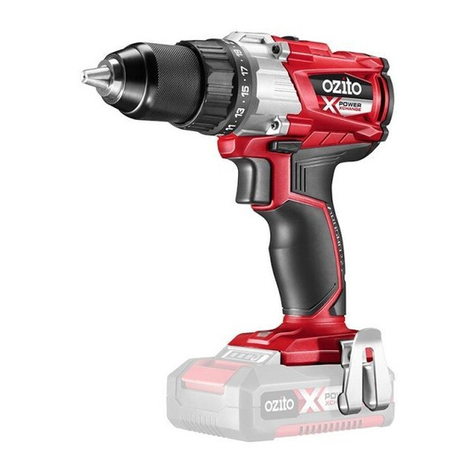
Ozito
Ozito Power X Change PXBDS-220 instruction manual

Milwaukee
Milwaukee 0375-1 Operator's manual
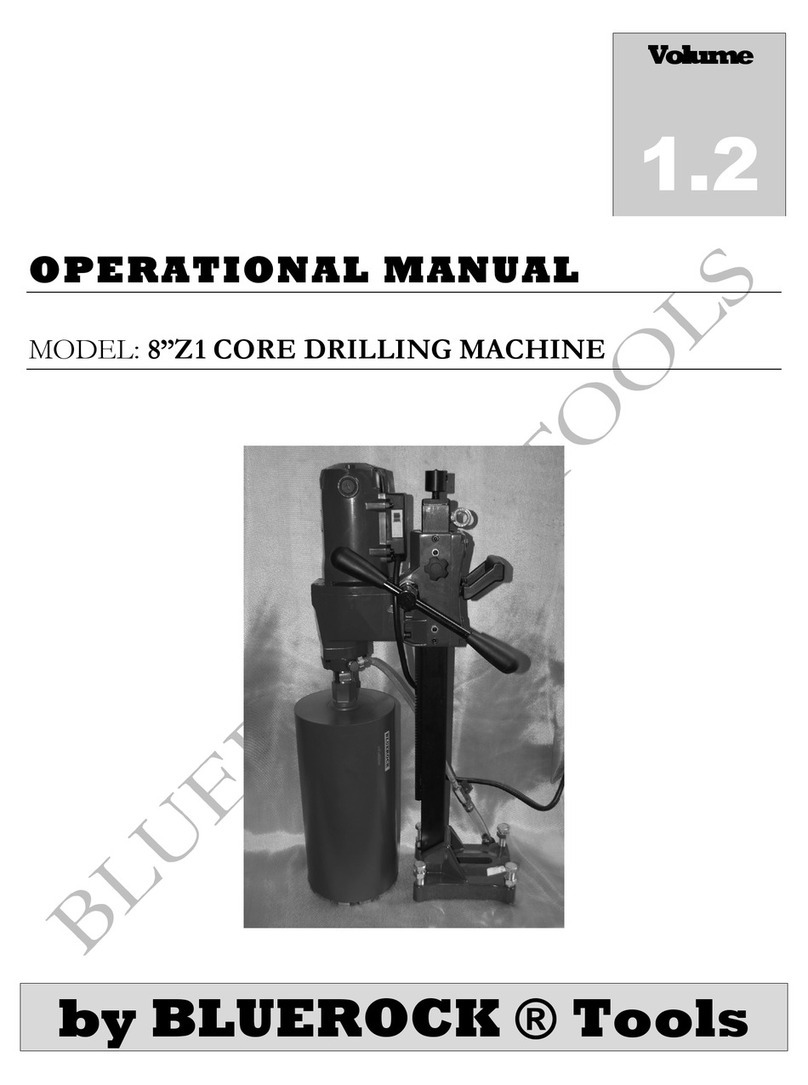
Bluerock Tools
Bluerock Tools 8"Z1 Operational manual

BDS
BDS MAB 100 K Original operating instructions
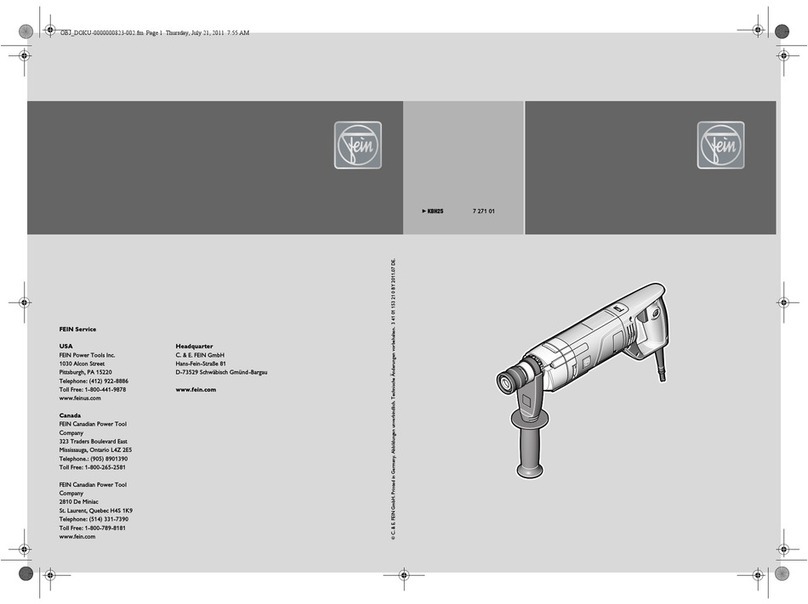
Fein
Fein KBH25 instruction manual

